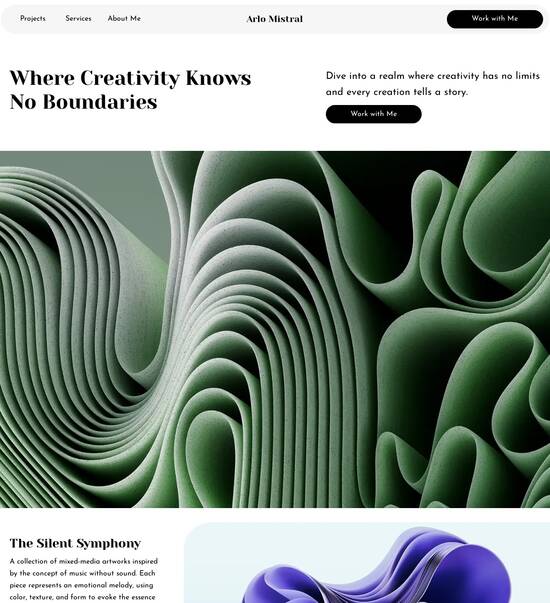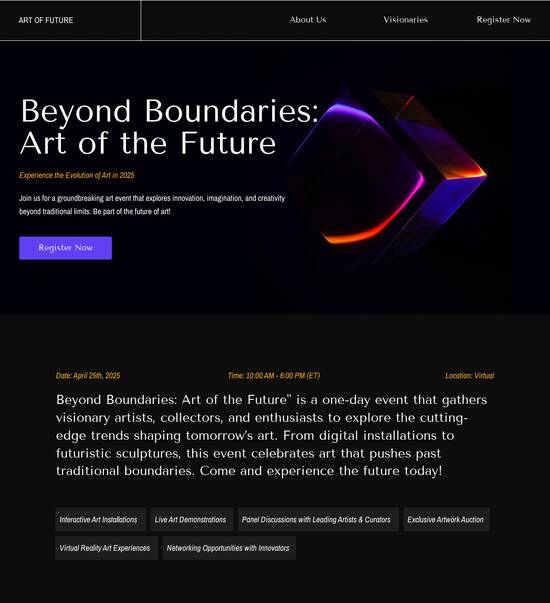
Bootstrap optimized referral page template
Explore Similar TemplatesAbout template
Supercharge your referral page with Bootstrap for outstanding performance! Learn more today.
Recommended templates

Easy to build without coding
With the intuitive drag-and-drop builder, anyone on your team can create high-converting pages without any knowledge of code or design. Make enhancements to your landing page with custom widgets using Javascript, HTML/CSS, or third-party scripts.

Multiple layouts for any industry and goal
Select from 500+ landing page layouts built to boost conversions across industry-specific scenarios. Customize them by adjusting fonts, adding images, and generating on-brand content with the AI assistant. Quickly scale with Instablocks® and Global Blocks that you can save, reuse, and update globally.

Loads fast and looks polished on any device
Every template is responsive, which means they present professionally on any device and load blazingly fast with our Thor Render Engine. You can also power them up with Google AMP technology to deliver an unparalleled mobile experience and drive higher conversions.

Robust analytics & experimentation
Get real-time updates and reporting across all your devices, showing the number of visitors, conversions, cost-per-visitor, and cost-per-lead. Launch AI-powered experiments, run A/B tests, and use heatmaps to analyze user behavior, then optimize your landing page to maximize conversions.







Easy to build without coding
With the intuitive drag-and-drop builder, anyone on your team can create high-converting pages without any knowledge of code or design. Make enhancements to your landing page with custom widgets using Javascript, HTML/CSS, or third-party scripts.
Multiple layouts for any industry and goal
Select from 500+ landing page layouts built to boost conversions across industry-specific scenarios. Customize them by adjusting fonts, adding images, and generating on-brand content with the AI assistant. Quickly scale with Instablocks® and Global Blocks that you can save, reuse, and update globally.
Loads fast and looks polished on any device
Every template is responsive, which means they present professionally on any device and load blazingly fast with our Thor Render Engine.
Robust analytics & experimentation
Get real-time updates and reporting across all your devices, showing the number of visitors, conversions, cost-per-visitor, and cost-per-lead. Launch AI-powered experiments, run A/B tests, and use heatmaps to analyze user behavior, then optimize your landing page to maximize conversions.
All the features you need to build lead-generating landing pages
Explore more featuresLearn how to build top-performing landing pages for any goal
FAQs
Leading the way in building high-performing landing pages





A comprehensive guide to the Instapage landing page and CRO platform
Instapage offers a powerful solution for marketers looking to optimize their digital marketing campaigns through high-converting landing pages. As the leading landing page platform in the USA, it enables the creation and customization of pages without any coding required. This guide provides a detailed overview of how to leverage Instapage to enhance your marketing efforts effectively.
Understanding Instapage and its capabilities
Instapage is designed to cater to various industries like business services, marketing, tech, education, and more. With a library of over 100 conversion-focused templates and an easy-to-use editor, users can create landing pages tailored to their specific audience and needs. This section explains how these features streamline the creation process while maximizing ROI.
- High-converting templates: Instapage's collection includes versatile layouts suitable for different marketing goals.
- A/B testing: By integrating built-in experiment features, users can optimize their landing pages to improve conversions significantly.
- Dynamic and personalized content: Instapage allows marketers to customize their content according to audience preferences, enhancing the user experience.
Steps to create a high-converting landing page
Creating an effective landing page with Instapage can be broken down into three straightforward steps.
Step 1: Choose a template and customize
Begin by selecting a template that aligns with your campaign goals. Customize it using the intuitive drag-and-drop builder, enabling you to incorporate elements crucial for lead generation.
- Select a template: Pick one that resonates with your brand's tone and marketing objectives.
- Add lead generation forms: Utilize pre-built elements that encourage user sign-ups and engagement.
- Configure tracking: Ensure your analytics are set up to measure performance effectively.
Step 2: Optimize for conversions
Once your page is designed, the next step is optimization to enhance conversion rates.
- Utilize heatmaps: These tools help you analyze user behavior and adjust your layout to improve overall engagement.
- Implement A/B testing: Run experiments with different versions of your landing page to determine which one performs best.
- Review analytics: Regularly check your performance metrics to harness insights that will inform future campaigns.
With these steps, you can create impactful landing pages that resonate with your audience and achieve your marketing goals.
Ready to transform your digital campaigns? Start using Instapage today and watch your conversions soar.
The evolution of referral page templates: harnessing Bootstrap for maximum engagement
The power of referral pages in digital marketing
Referral pages are dedicated web pages designed specifically to encourage users to refer products or services to others. They often showcase benefits, incentives, and easy methods for sharing. These pages function as pivotal tools in digital marketing strategies, capitalizing on the power of word-of-mouth and social sharing to generate leads and conversions.
Statistics indicate that referral marketing can have a significant impact on a business's bottom line; for example, referred customers are 4 times more likely to convert than non-referred customers. Additionally, customers acquired through referrals often have a higher lifetime value, highlighting the importance of referral pages in any marketing arsenal.
Analyzing the landscape of digital referrals
As we look at the trends in referral marketing, it's evident that user expectations are evolving. Today, users expect seamless experiences that involve minimal effort from their side. Additionally, platforms are shifting towards influencer marketing and social commerce, where referrals not only come from friends but also from trusted voices within social networks.
Major players in the referral market, like Dropbox and Airbnb, have set the standard high with their successful referral programs. By analyzing how these companies structure their referral pages, marketers can glean valuable insights into what resonates with users and how to create engaging content that drives conversions.
Bootstrap framework: a catalyst for responsive design
Bootstrap is an open-source front-end framework that enables developers to create responsive and mobile-first web applications with ease. Originally developed by Twitter in 2011, its key purpose was to streamline development by providing a foundation of pre-designed components. Today, Bootstrap is one of the most popular web design frameworks, adored for its versatility and user-friendly features.
Among its many features, Bootstrap offers a responsive grid system, extensive pre-built components, and flexibility in customization. This ensures that websites look great on any device or screen size, thereby improving the overall user experience. The framework’s commitment to mobile-first design is particularly significant, as most users now access sites on their smartphones.
The science behind Bootstrap’s grid system
Bootstrap employs a grid-based layout that divides the screen into a uniform structure of rows and columns. This responsive grid system adjusts seamlessly as the screen size changes, allowing for optimized viewing across various devices. By using the grid, designers can create layouts that are visually appealing while remaining functional.
The mobile-first approach in Bootstrap ensures that designs prioritize smartphone users, which is crucial as mobile traffic continues to dominate. Responsive web design not only enhances user satisfaction but also contributes positively to search engine rankings, making it an essential aspect of any referral page.
Crafting an optimized referral page template
Creating an optimized referral page template involves several key elements that work together to engage the audience. First, compelling headlines and subheadings are vital for capturing attention right away. A well-crafted headline piques curiosity, leading readers to dive deeper into the page.
Another essential component is the incorporation of high-quality images that communicate the brand's message and encourage sharing. Visuals play a significant role in conversion rates, as they can simplify complex ideas and evoke emotional responses. Lastly, strategic calls to action must be placed throughout the page to guide users toward specific actions, such as signing up or referring friends.
Integrating humor and personality into the design
Adding humor and personality to referral pages can significantly enhance user engagement. Examples of companies that successfully incorporate humor include Grammarly and Mailchimp, both of which create playful content that engages users and encourages them to share. This light-hearted approach not only entertains but also builds a connection, making users more likely to refer others.
The psychology behind using humor in marketing shows that fun and relatable content increases the likelihood of sharing. When users find something amusing, they often share it with friends and family, leading to organic referrals that can boost conversions.
Features and functionalities of an optimized Bootstrap referral page
Customization options are crucial for reflecting brand identity on a referral page. With Bootstrap, marketers can easily integrate brand colors, fonts, and styles into their design. Using variables and Sass in Bootstrap makes it possible to maintain branding consistency across all pages. Typography and color schemes significantly influence how users perceive a brand, making it vital to choose these elements wisely.
Interactive components, such as modals, tabs, and carousels, can enhance user flow and make information delivery more engaging. These elements not only keep users interested but also facilitate navigation through different sections of content, helping them find relevant information without feeling overwhelmed. When users interact with your referral page, they are more likely to retain information and engage further.
Data-driven decisions: conducting research to enhance conversion rates
Analyzing user behavior using analytics tools is a foundational step in optimizing referral pages. Implementing A/B testing can help compare different layouts, headlines, and content pieces to identify what resonates best with your audience. For instance, running tests on different call-to-action buttons can offer insights into colors, positions, and wording that drive more clicks and conversions.
Additionally, reviewing case studies that demonstrate data-driven successes can provide valuable lessons on how to structure referral programs. Observing how successful companies analyze user behavior offers practical ideas and proven strategies that can be applied to your referral page.
Collecting feedback: the role of surveys and user testing
Feedback is essential for enhancing referral page effectiveness. Structuring surveys to gather actionable insights can help understand user preferences and pain points. Asking specific questions about user experiences can point to areas for improvement while making customers feel valued.
Moreover, conducting user testing allows marketers to observe users interacting with the page in real-time. This method provides invaluable input for refining design elements and content, leading to more successful referral initiatives going forward.
The role of images and visuals in referral pages
Selecting the right visuals for referral pages is paramount. Images should not only be high quality but also relevant to the product or service being promoted. Utilizing visuals that evoke emotions can enhance connections with users, encouraging them to share the content with their networks.
Moreover, incorporating user-generated content—like testimonials and reviews—can reinforce authenticity and trustworthiness, making prospects feel more confident in referring others. When potential referrals see authentic content from real users, it strengthens the credibility of the brand.
Optimizing images for performance
Optimizing images for performance is crucial to ensure fast load times on referral pages. Techniques such as image compression and lazy loading can significantly improve page performance. Tools like TinyPNG help reduce image sizes without compromising quality, which can lead to quicker load times and better user experiences.
Evaluating image performance and loading speeds using diagnostic tools can enable marketers to identify bottlenecks and enhance overall page efficiency. Fast-loading referral pages help reduce bounce rates and improve engagement rates.
Topic variations: tailoring your referral page for different audiences
Understanding your target demographic is essential for creating effective referral pages. Audience segmentation involves identifying distinct groups within your audience based on criteria such as demographics, interests, and behaviors. This information can guide content personalization, making it more relevant and compelling.
Personalizing content allows marketers to direct specific messages to unique audience profiles. For example, tech-related content may need different imagery and language compared to educational material. Developing various topic clusters around your referral campaigns helps ensure content diversity while driving traffic effectively.
Crafting custom blog posts for varied topics
Creating custom blog posts to support referral pages involves strategically intertwining relevant topics that appeal to your segmented audiences. Structuring these blog posts with clear connections to referral initiatives creates a cohesive journey for users, inviting increased sharing and referrals.
This approach not only drives traffic to your referral page but also enhances SEO efforts by creating authority around specific topics. By clustering related content, marketers establish expertise within various niches, encouraging users to refer their friends.
Headline crafting: the art of captivating attention
Compelling headlines are vital for driving engagement on referral pages. Techniques for crafting attention-grabbing headlines include using questions, lists, or how-to formats that create curiosity and invite clicks. Successful headlines build anticipation for the content that follows.
Incorporating A/B testing for headlines can reveal which formulations perform best, helping marketers understand audience behavior. Keeping headlines fresh and relevant is a continuous process that contributes to improving click-through rates significantly.
The role of SEO in headline optimization
Search engine optimization plays a crucial role in enhancing online visibility. Crafting headlines that incorporate primary keywords while maintaining originality ensures that your content ranks well without sacrificing creativity. Suggested tools, such as Google Keyword Planner, help in refining keyword strategies.
Continuous headline analysis not only aids in optimization but also keeps content relevant and interesting for target audiences. Keeping abreast of SEO trends is essential in refining strategies for maximum impact.
Finalizing and testing your referral page
Before launching a referral page, ensuring cross-browser compatibility and mobile responsiveness is crucial. Using tools like BrowserStack enables comprehensive testing across various devices, identifying any related issues that could hinder user experience. Ensuring a seamless experience across platforms is critical, as any inconsistencies could lead to missed opportunities.
Additionally, common pitfalls in referral page development could include overly complex designs or unclear navigation. Keeping the referral process straightforward significantly boosts conversion potential.
Launch strategies: preparing for a successful go-live
Utilizing social media and email marketing for initial traffic can set the tone for a successful launch. By promoting the referral page across different channels, marketers can maximize audience reach right from the get-go. Tracking performance post-launch is pivotal for measuring success and enables timely adjustments based on user engagement.
Engaging with audiences post-launch fosters community participation and enriches the referral experience. Marketers should remain responsive and adapt to real-time feedback to optimize performance further.
Future trends: evolving referral strategies in digital marketing
As digital marketing continues to evolve, the integration of AI and automation in referral marketing becomes increasingly vital. AI-driven tools can analyze user data to create personalized experiences, enhancing user satisfaction. For instance, chatbots can facilitate real-time interactions during the referral process, guiding users and enhancing the likelihood of conversion.
As innovations continue to emerge, tracking trends in referral page development can provide insights into potential future strategies. Advancements in technologies such as virtual and augmented reality (VR and AR) offer exciting possibilities for presenting products and referral opportunities in groundbreaking ways.
Innovations to watch in referral page development
Marketers should keep an eye on the shifting landscape of referral marketing as new tools arise. Using data analytics, improved tracking capabilities, and sophisticated targeting can optimize campaigns for better results. Preparing for these changes equips marketers to remain competitive and effective in leveraging referral marketing.
The future of digital marketing is promising, with opportunities to engage users in more interactive and personalized ways. Staying adaptable and vigilant in adopting innovations will be key to sustaining success in referral initiatives.
Ready to skyrocket conversions?
Supercharge your ad campaigns with high-performing landing pages
Get started














